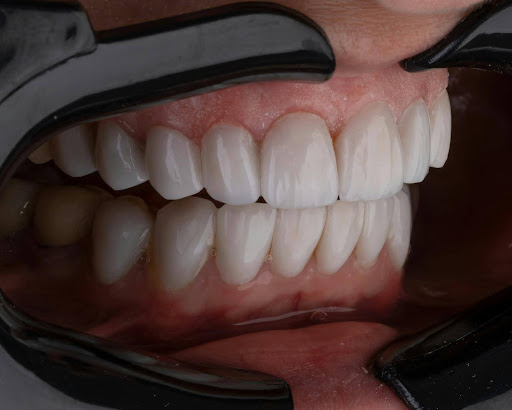Invisalign has become a popular alternative to traditional braces, offering a discreet, comfortable, and effective way to straighten teeth. If you’re thinking about starting Invisalign treatment, one of the most common questions is: how long does it take to work?
The answer isn’t the same for everyone, as treatment time can vary based on your specific dental needs. However, understanding the average timeline, how Invisalign works, and what to expect at each stage will help you feel more confident before getting started.
This guide will explain the typical Invisalign treatment duration, what factors can affect how quickly it works, and what you need to know to get the best results.
What is Invisalign and how does it work?
Invisalign is a type of clear aligner system used to straighten teeth. Instead of metal brackets and wires, Invisalign uses a series of custom-made plastic aligners that gently shift your teeth into place over time. Each aligner is worn for around one to two weeks before being swapped for the next in the series.
You’ll need to wear your aligners for 20 to 22 hours per day to get the most effective results. They should only be removed when eating, drinking anything other than water, and brushing your teeth.
Because they’re almost invisible, many adults and teenagers choose Invisalign Clapham as a more discreet option for orthodontic treatment.
How long does Invisalign take to work?
The average Invisalign treatment takes between 6 and 18 months. However, some patients begin to see visible changes in their smile in just a few weeks. Your total treatment time will depend on several factors, including how complex your case is and how well you follow your dentist’s advice.
For example:
- Mild crowding or small gaps may take as little as 6 months to correct.
- Moderate alignment issues typically require around 12 months.
- More complex cases involving bite problems or significant crowding may take up to 18 months or longer.
Your dentist will provide a personalised treatment plan during your consultation, including an estimated timeline based on your specific case.
What factors affect how long Invisalign takes?
No two smiles are the same, which means Invisalign works slightly differently for each person. Several factors can influence how long your treatment takes:
- The complexity of your case
Minor spacing or alignment issues will naturally take less time to correct than more severe orthodontic concerns. If you have a significant overbite, underbite, or rotated teeth, your treatment may require more aligners and a longer duration. - How often you wear your aligners
For Invisalign to be effective, the aligners must be worn for 20 to 22 hours a day. If you frequently take them out or forget to wear them consistently, your treatment may be delayed. Following your dentist’s instructions closely is the best way to stay on track. - Your age
Invisalign tends to work faster in teenagers and younger adults because teeth move more easily when you’re younger. However, many adults still achieve excellent results—it may just take slightly longer. - Whether you need attachments or elastics
Some patients may need small tooth-coloured attachments or rubber bands to help with more complex movements. These extra components may be used for part of the treatment and can extend the timeline slightly, depending on how your teeth respond. - Your oral hygiene and dental health
Keeping your teeth and gums healthy during treatment is essential. If problems like gum disease or tooth decay arise mid-treatment, they may delay your progress while these issues are addressed.
What should you expect during Invisalign treatment?
Your journey will begin with a full consultation, where your dentist will assess your teeth, take digital scans, and create a 3D treatment plan. This plan shows how your teeth will move over time and gives you a clear idea of what your final result will look like.
Once you begin treatment, you’ll wear each set of aligners for 7 to 14 days, depending on your dentist’s recommendation. You’ll also have regular check-ups—usually every 6 to 8 weeks—to make sure your teeth are moving as expected.
Many patients report feeling mild pressure or discomfort when switching to a new aligner, which is a sign that the treatment is working. This sensation typically settles after a couple of days.
Can Invisalign speed up treatment compared to braces?
In some cases, Invisalign can be faster than traditional braces, particularly for simple or moderate issues. Because the treatment is planned digitally and uses advanced materials, tooth movements can be more precise and efficient.
However, for more complex cases, the timeline is often similar to fixed braces. The biggest advantage of Invisalign is not necessarily speed but the combination of comfort, discretion, and flexibility it offers.
How can you make Invisalign work faster and more effectively?
If you want to keep your treatment on schedule, there are a few simple tips to follow:
- Wear your aligners for at least 20 to 22 hours per day
- Only remove them for eating, drinking, brushing, and flossing
- Keep your aligners clean and avoid damaging them
- Attend all scheduled dental check-ups
- Follow your dentist’s guidance about when to switch to the next aligner
In some cases, your dentist may use additional tools like vibration devices or remote monitoring apps to help encourage faster progress, but the most important factor is how closely you stick to the routine.
What happens after Invisalign treatment?
Once your Invisalign journey is complete, you’ll need to wear retainers to keep your teeth in their new position. Retainers are usually worn full-time at first, then gradually reduced to night-time only.
Without retainers, there’s a risk that your teeth may begin to shift back. Your dentist will explain how long you’ll need to wear them, but in most cases, retainers are a long-term part of keeping your smile straight.
Is Invisalign right for everyone?
Invisalign is suitable for most people, but not every case can be treated using clear aligners alone. If your orthodontic issues are particularly severe or involve significant jaw alignment problems, your dentist may recommend traditional braces or a combination of treatments.
During your consultation, your dental team will assess your smile and let you know whether Invisalign is the best option for your goals and dental health.
Conclusion
Invisalign offers a discreet, comfortable, and highly effective way to straighten your teeth. Most patients complete their treatment within 6 to 18 months, although this varies based on individual needs and how closely you follow your treatment plan.
Before starting Invisalign, it’s important to understand how it works, what to expect at each stage, and how you can help your treatment stay on track. With the right care and guidance, you’ll be on your way to a straighter, healthier smile in no time.
If you’re considering Invisalign, book a consultation with your dentist to find out more about your personalised treatment plan and how long it might take for you.




